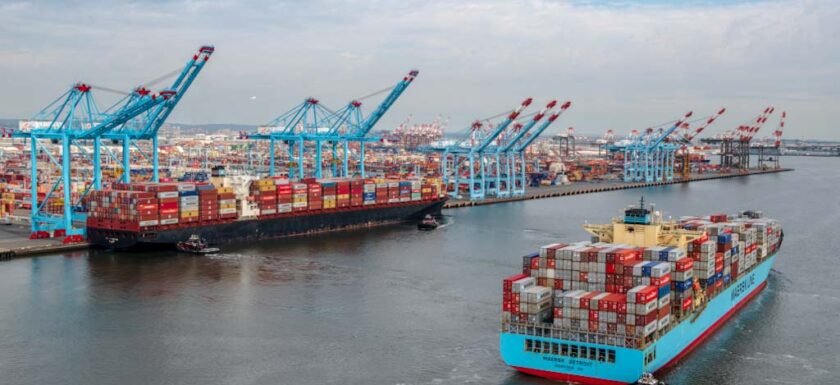Lease Agreement Secures Major Investments and Capacity Enhancements at Port of New York and New Jersey’s Second-Largest Container Terminal
Agreement Establishes New Framework for Public-Private Partnerships and Strengthens Port’s Ability to Handle Growing Cargo Demand, Delivering Goods that Power the Region
Proposed Deal Subject to Vote by Port Authority Board of Commissioners on March 27
The Port Authority of New York and New Jersey today announced a landmark 33-year lease extension with APM Terminals, the operator of the Port of New York and New Jersey’s second-largest container terminal. This agreement includes major investments and capacity enhancements by APM Terminals at its container terminal, setting a new framework for container terminal agreements and further strengthening the East Coast’s busiest port to meet rising cargo demand.
APM Terminals is an independent division of Denmark-based A.P. Møller – Mærsk, an integrated logistics company. Its lease extension with the Port Authority takes the unique, nontraditional approach of incorporating performance, infrastructure, and sustainability requirements into the contract, ensuring steps are taken to enable the terminal to handle growing cargo volumes while prioritizing customer service and sustainability. This extension, along with similar long-term agreements with other major tenants at the port, is a key step in growing the port’s business, building confidence across the supply chain and solidifying the Port of New York and New Jersey’s position as a reliable, efficient gateway for goods.
“Our region is an irreplaceable driver of the U.S. economy, serving as home to one of the busiest ports in our nation’s supply chain,” said New Jersey Governor Phil Murphy. “In addition to getting goods into the hands of millions of consumers across the country, the Port of New York and New Jersey creates hundreds of thousands of good-paying jobs for our communities. This lease extension with APM Terminals will play an important role in sustaining the growth and competitiveness of our port.”
“This landmark agreement with APM Terminals underscores the essential role the Port of New York and New Jersey will continue to play in powering the regional and national economy,” said Port Authority Chairman Kevin O’Toole. “APM has been a trusted partner at the port for decades, and we’re eager to build on that strong foundation as we push towards our shared goals of growing this gateway’s productivity, efficiency, and dependability for the good of the region and the nation.”
“This lease extension secures transformative infrastructure and capacity enhancements at the second-largest container terminal in the East Coast’s busiest port,” said Port Authority Executive Director Rick Cotton. “These commitments will enable the Port of New York and New Jersey to move more goods, create more jobs, and further cement its role as an essential driver of our region’s economy and our nation’s supply chain.”
“This agreement delivers long-term certainty for the port, its customers, and the entire supply chain,” said Bethann Rooney, port director at the Port Authority of New York and New Jersey. “With APM Terminals’ commitment through 2062, we are solidifying the Port of New York and New Jersey as a stable, reliable choice for shippers — one that is well-positioned to handle growing cargo demand while maintaining its reputation for world-class efficiency and service.”
The Port Authority Board of Commissioners will vote on the lease extension at its meeting on March 27. APM Terminals’ new lease extends the term through December 2062, from its current expiration in December 2029, and requires payment to the Port Authority of an extension fee and modified annual rental payments.
As part of the agreement, APM Terminals will invest over $500 million over the coming years to enhance cargo-handling capacity at its 350-acre terminal. APM Terminals has also committed to the replacement and maintenance of all wharf and berth structures. This investment supports the Port Authority’s Port Master Plan 2050, which anticipates cargo volumes doubling or tripling by mid-century. APM Terminals has also committed to future capacity enhancements driven by demand. Additionally, the Port Authority and APM Terminals will expand the lease to include portions of an adjacent parcel of land to APM Terminals for enhanced productivity.
Building on the Port Authority’s industry-leading sustainability initiatives, APM Terminals has pledged to achieve net-zero greenhouse gas emissions in its operations and support the Port Authority’s goal of reaching net zero agency-wide by 2050. Under the new agreement, APM Terminals will invest in zero-emission cargo-handling equipment over the coming years. As a Port Authority lessee, the terminal operator is also subject to the Port Authority’s marine terminal tariff, which incentivizes the adoption of cleaner equipment as new technology becomes commercially available.
The agreement also strengthens collaboration between the Port Authority and APM Terminals on key priorities, including safety and security, innovation, customer experience, performance standards, and enhanced reporting on terminal operations.
With this lease extension, most of the Port of New York and New Jersey’s major tenants are now secured under long-term agreements — APM Terminals through 2062, Port Liberty Bayonne and New York through 2047, and Port Newark Container Terminal through 2050. This long-term certainty strengthens the port’s position as a stable, reliable hub for global trade and provides terminal operators with the confidence to make long-term investments.
The Port of New York and New Jersey is the busiest port on the East Coast and among the top three busiest in the country as the first East Coast port of call for the vast majority of transatlantic container vessels. In 2024, it handled approximately $264 billion worth of goods, moving 8.7 million TEUs (twenty-foot equivalent units). Port operations supported more than 563,000 industry jobs in the New York-New Jersey-Pennsylvania region, according to a study of 2022 maritime economic activity by the Shipping Association of New York and New Jersey.
# # #

